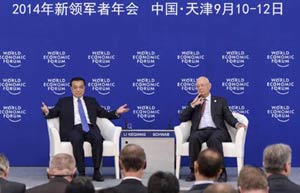In China, we see overcapacity in aluminum smelting but low capacity to produce high-end fabricated aluminum products. How does Alcoa view this situation?
We continue to see the Chinese market as largely self-contained, meaning that the country does not import or export primary aluminum and instead adjusts domestic capacity to ensure production equals consumption. Supply and demand in the country is essentially in balance and continues to be managed to equilibrium. Even as China replaces high cost capacity in the east with new state-of-the-art smelters, the economics remain unsupportive of existing capacity.
The Chinese government is implementing policies to reduce aluminum production, and as producers take steps to curb overcapacity in the primary aluminum industry we remain ready and willing to share our vast experience in facility curtailment and decommissioning. We have learned through our experience that, done right, there are ways of reducing aluminum capacity while re-purposing decommissioned smelting facilities into new business sites that increase economic output and employment opportunities for local communities.
At the same time, we support China's goal of increasing value-added aluminum production and our partnership with China Power Investment is intended to capture growth for high-end fabricated products in the aerospace, automotive, commercial transportation, consumer electronics and packaging markets in China.
So far in 2014, Alcoa has announced the closure of 424,000 tons of smelting capacity in the US, Australia, and Italy and curtailed 147,000 tons of capacity in Brazil. How is Alcoa dealing with the challenging market conditions for the industry?
We continue to execute our strategy of creating a globally competitive commodity business by taking decisive actions to bring our upstream business down the cost curve. Our recently announced closure of Portovesme smelter in Italy late last month will reduce our global smelting capacity by 150,000 tons to 3.6 million tons per year.
In the past year, we have also closed high-cost smelting capacity in Australia and the US and curtailed capacity in Brazil. We are also focused on implementing cost reductions and productivity improvements across our global system and recently brought the world's lowest cost smelter on line when our Saudi joint venture with Ma'aden started commercial operations earlier this month.
At the same time, we are growing our value-added businesses to capture growth opportunities. In 2013, 57 percent of Alcoa's revenues and almost 80 percent of our profits came from our value-added businesses which supply titanium, nickel and aluminum products to the aerospace and automotive industries, among others. Global demand across our end markets continues to grow and Alcoa is well positioned to meet that demand.
Alcoa has earned a global reputation for its health and safety standards. This remains a very important issue for manufacturers in China. Could you share some advice with Chinese manufacturers?
We hold Alcoa's businesses in China to the same high health and safety standards as all of our operations around the globe. The health, safety, and well-being of employees is a top priority at Alcoa, and 2013 was statistically our safest year ever. Last year we introduced the "Stop for Safety" program which rewards employees for stopping work when they come upon a potentially unsafe situation.
As China tightens enforcement of health and safety standards, we believe it is critical for Chinese manufacturers to recognize that high standards directly benefit them through increased productivity. A company's greatest assets are its employees, and there should be no shortcuts when it comes to worker safety.
Through your membership in Premier Li's Global CEO Council, you recently gave some advice on the steps China can pursue to establish an innovation-based economy. What did you share with Premier Li?
China's future growth model and economic development will be driven by innovation. I shared with Premier Li my belief that the country's policymakers should lead in establishing the conditions that foster an innovation ecosystem where innovators, technology, and markets can truly flourish.
The key foundations of an innovation ecosystem as I see it include the following pillars: public-private partnerships, smart policies and regulatory regimes that incentivize innovation, strong intellectual property rights and enforcement that protect innovators and investors, and development of a skilled workforce.
Global multinationals such as Alcoa can play a key role in this new growth model by serving as a knowledge platform and implementing partner. In fact, we are already sharing our expertise through partnerships with China Power Investment and the Commercial Aircraft Corp of China and at forums such as the World Economic Forum 2014 Annual Meeting of New Champions, Global CEO Council, and Shanghai International Business Leaders Advisory Council.
 |
 |
|
|
|
